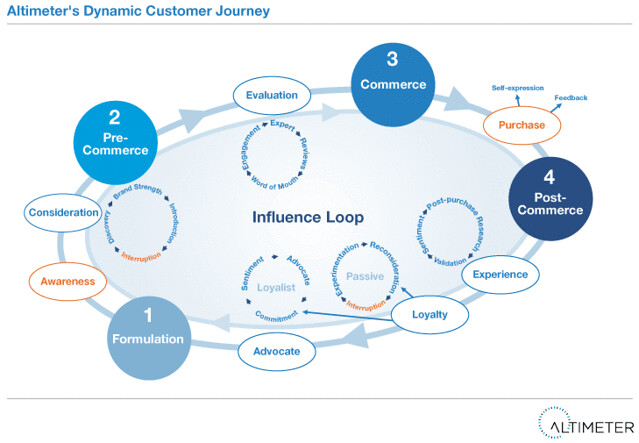Once a brand has determined that social is an appropriate part of their marketing strategy, the next question is what exactly should that strategy be?
Without thought, brand can open up multiple social accounts and start posting. But what? And why?
Here are a few thoughts that may help start to frame the answer to that question.
I recommend starting by looking at your customer journey from discovery, through evaluation, purchase, and post-purchase engagement and use that to help frame things.

New brand — social awareness and discovery
If you’re a brand new brand, you’re looking to help audiences discover you. This is where most of the startups I talk to live.
You can find many lists of top ways people discover brand and products. Just two are below — with links to more details.
Naturally there are lots of follow on questions you may have about these lists, not the least of which is around demographics — if your product is targeted at Millennial men, you’ll have a different discovery list than if your product is targeted at the AARP generation.
But moving on.
| Forrester
Brands and products discovered in the following ways (in order):
|
Globalwebindex
Brands and products discovered in the following ways (in order):
|
Bottom line, for new brands, once you’ve decided that social is needed as part of the mix to help new audiences discover your product, a social reach strategy is likely to be your primary initial focus to help people discover you.
Social reach strategies may include simple, and more complex, tactics such as:
- Highly targeted and optimized social advertising
- Making everything you produce socially sharable — emails, collateral, articles, blog posts — everything
- Producing content — articles, visuals, data, charts — whatever makes sense — that speaks personally to the audience on social, and/or rides current trends relevant to your brand; content should always be useful and thoughtful, rather than ‘pitchy.’
- Inviting others to write and share best practices, articles, and rich content that can get shared socially
- Run social promotions such as contests, sweepstakes, games that invite social participation. At Friend2Friend we run ‘instant win’ promotions that get upwards of 100,000 entries over a short period. And every single person submits an email address. It works!
- Nurturing trustworthy social advocate communities and influencers to help spread the word
- Devising socially savvy “real world” events (see AirBNB’s growth hacking tactics for new markets) that introduce products to new audiences. Remember Tupperware parties and Botox parties? They worked!
- Partner with other brands to share mutually beneficial social outreach
Established brands — social exploration and evaluation
If you’re an already-established brand in a highly competitive space, who is looking to steal customers from your competition, the focus might be on both brand discovery, but more importantly brand exploration. At Friend2Friend we’ve built social-powered gift catalogs for example, that allow social fans ‘vote’ up their favorites. Similarly, the PGA Tour SuperStore built a socially-powered Gift Guide on their online store during their 2013 holiday season. Customers chose products by voting for their favorite holiday golf gifts. The results were impressive. The store saw over 40% increase in conversions from visitors, and those visitors spent an average of 21% longer in time on the site. Social exploration tactics might include asking fans to submit their stories and photos about a product for others to share, and getting customers to review and rate products. Sephora has done this beautifully with their BeautyTalk site. Beauty products can be purchased in many places, but by ensuring that the purchase comes along with some great advice too, the click to buy becomes much easiery. Again, the results have been impressive.
Dominant brands — social relationships and brand loyalty
Finally, you may already be a dominant player in your field, and you want to keep customers from leaving you for the competition, in which case your social plans may be focused on social relationship marketing — by using social to reinforce your brand’s position. There are so many great examples of this, and they all involve an extremely social-focused customer service strategy where customers arrive, and leave, with a great experience they want to talk about. Plus, all the great examples of loyalty programs that reward customers for staying customers.This isn’t to say new brands shouldn’t nurture their brand new sets of customers on social. Far from it. But their focus shouldn’t be on integrating a serious social customer relationship system until that need becomes overwhelming.
With such a rich array of social tools to choose from, and social tactics to deploy, understanding your overarching goal should be the first thing you do on social. Without that, you won’t know what technology tools and platforms to deploy, and you won’t be able to know for sure whether your tactics moved your business needles.
So start with where you want to focus your efforts in your customer journey, and take it from there.
